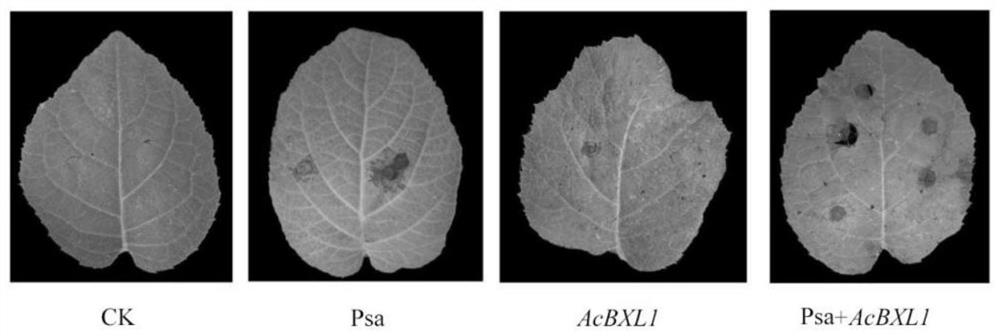Kiwi fruit canker susceptible gene AcBXL1 and application thereof
A technology for kiwifruit canker disease and susceptible genes, which can be applied in application, genetic engineering, plant genetic improvement and other directions, and can solve the problems of difficult control and invasion of chemicals
- Summary
- Abstract
- Description
- Claims
- Application Information
AI Technical Summary
Problems solved by technology
Method used
Image
Examples
Embodiment 1
[0049] Example 1 Acquisition and sequence analysis of the gene AcBXL1 susceptible to ulcer disease
[0050] 1. AcBXL1 gene transcriptome and fluorescence quantitative analysis
[0051] Fluorescence quantitative experimental treatment: The test materials were taken from the tissue culture seedlings of the disease-resistant kiwifruit variety 'Jinkui' and the susceptible kiwifruit variety 'Hongyang'. Use sterile water as a control, use OD 600 =0.6 Psa bacteria solution respectively treated the tissue culture seedlings for 1h, 6h, 12h, 24h, 48h, 96h, and then put them in -80°C refrigerator to store the samples.
[0052] Through the transcriptome analysis of the resistant variety 'Jinkui' and the susceptible variety 'Hongyang', the gene AcBXL1 that was down-regulated in 'Jinkui' and up-regulated in 'Hongyang' was selected. After inoculating the leaves of 'Jinkui' and 'Hongyang' kiwi fruit tissue culture with Psa bacteria solution for 1h, 6h, 12h, 24h, 48h and 96h, the expression ...
Embodiment 2
[0060] Example 2 Genetic transformation of susceptible ulcer gene AcBXL1
[0061] 1. Construction of AcBXL1 gene p1300 vector (for transient expression of the gene and transgenic kiwi fruit)
[0062] According to the function of the pCAMBIA1300 vector, the target gene is inserted behind the 35S promoter, and the vector has its own EGFP marker gene, which satisfies the functions of subcellular localization and gene overexpression at the same time. According to the optional enzyme cutting sites (Xba I and BamH I) of the p1300 vector, the following homology arm primers were designed using the software (CE Design V1.04) provided by Novizyme:
[0063]
[0064] Re-amplify the target gene fragment by PCR using primer pairs with homologous restriction sites, purify the fragment and measure its concentration. The amplification system is as follows:
[0065] cDNA 2.0μl AcBXL1-Xba I-F (10μM) 2.0μl AcBXL1-BamH I-R (10μM) 2.0μl I-5 enzyme 25.0μl wx...
Embodiment 3
[0085] Example 3 Analysis of AcBXL1 gene promoter activity
[0086] 1. Construction of P1391Z promoter vector
[0087] First, the CE Design V1.04 software of Novizyme Company was used to design restriction primers for the sequenced correct AcBXL1-based promoter sequence (Table 1). Use the AcBXL1 gene promoter bacterial liquid that has been cloned to the correct sequence to plan, pick and shake the AcBXL1 promoter bacterial liquid, use the AcBXL1 promoter bacterial liquid as a template, and use KOD enzyme to perform high-fidelity PCR amplification. Add 10 μL of 6×Loading Buffer to the tube and mix by pipetting for subsequent electrophoresis detection and gel cutting recovery.
[0088] Table 1 Primers required for promoter vector construction
[0089]
[0090] Use Takara's fast cutting enzymes quickcut-BamHI and quickcut-EcoRI to perform double digestion on the restriction sites BamHI and EcoRI of the pCambia 1391Z vector. After the target band is detected by electrophoresi...
PUM
 Login to View More
Login to View More Abstract
Description
Claims
Application Information
 Login to View More
Login to View More - R&D
- Intellectual Property
- Life Sciences
- Materials
- Tech Scout
- Unparalleled Data Quality
- Higher Quality Content
- 60% Fewer Hallucinations
Browse by: Latest US Patents, China's latest patents, Technical Efficacy Thesaurus, Application Domain, Technology Topic, Popular Technical Reports.
© 2025 PatSnap. All rights reserved.Legal|Privacy policy|Modern Slavery Act Transparency Statement|Sitemap|About US| Contact US: help@patsnap.com



